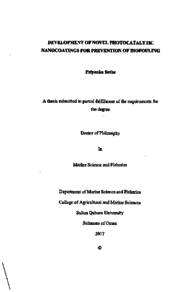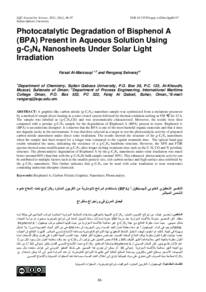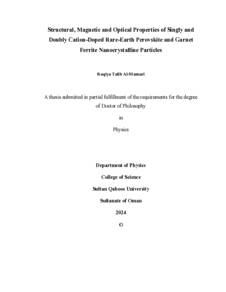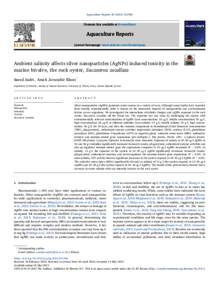Document
Development of novel photocatalytic nanocoatings for prevention of biofouling
Publisher
Sultan Qaboos University
Gregorian
2017
Language
English
English abstract
The billion dollar maritime industry is plagued by biofouling leading often to heavy economic penalties. While biocidal paints have been effectively used to reduce biofouling, their associated environmental and toxicology impacts has demonstrated the urgent need of more ecologically acceptable biofouling protection methods. This thesis explores the use of bioinspired zinc oxide (ZnO) nanorods coatings on various substrates which due to photocatalysis produce Reactive Oxygen Species (ROS) preventing biofouling. As a prior investigation, the antifouling (AF) properties of ZnO nanorod (ZnO NR) coated glass substrata were investigated in an out-door mesocosm experiment under natural sunlight. This study demonstrated the effective reduction in density and viability of fouling bacteria and diatoms using ZnO nanorod coating. In the following experiment, AF properties of ZnO NR coated fishing nets were tested and compared with commercial biocidal AF paint during the one month field experiment at Al Mouj marina, Muscat to evaluate their possible application in aquaculture installations. Our results demonstrated that the nanocoated net was significantly better compared to the nets painted with the AF paint in terms of antifouling performance. Metagenomic analysis using Illumina MiSeq sequencing showed that the nanocoated net had similar fouling communities as the control net whereas the nets with AF paint led to the harbouring of harmful organisms. In the next step, ZnO NRs were grown on commercial water filter (polypropylene substrate) and their potential application towards water treatment using solar light was investigated. The results showed that the nanocoated polypropylene substrates have antibacterial and antialgal properties upon photocatalysis and it also prevented regrowth of algae after the photocatalytic treatment. Nanocoated substrate also effectively disinfected natural well water using solar light which suggests that such substrates potentially can be used in water treatment plants. In the last experiment, toxicity of ZnO NRs unsupported and supported on glass substrate, Zno nanoparticles (NPs) and Zn2+ ions was investigated using Artemia salina larvae, Dunaliella salina (alga) and Bacillus cereus (bacteria). The results clearly highlighted the differences of sensitivity of tested organisms towards NPS, NRs and Zn2+ ions. Supported ZnO NRs showed the least toxicity compared to nanoparticles and Zn* ions for all the tested organisms. In conclusion, this study demonstrated that ZnO NRs supported on various substrates can be a good low toxic alternative to modern toxic antifouling methods.
Description
Thesis
Member of
Resource URL
Arabic abstract
واجه صناعة النقل البحري خسائر تقدر بمليار دولار بسبب مشاكل التكتلات الحيوية والذي يصل في كثير من الأحيان العقوبات اقتصادية كبيرة. في حين أن دهانات المبيدات الحيوية يتم استخدامها بشكل فعال للحد من التكتلات الحيوية . لكن يعزى اليها العديد من التأثيرات البيئية والسمية وبالتالي هناك حاجة ماسة إلى المزيد من أساليب الحماية المقبولة بيئيا. هذه الرسالة تستكشف استخدام طلاءات أعواد أكسيد الزنك النانونية على ركائز مختلفة من خلال توفر تحفيز ضوئي لإنتاج أنواع الأكسجين التفاعلية وذلك لمنع التكتلات الحيوية. كمتابعة أولية، تم التحقق من الخصائص المتعلقة بمنع التكتلات الحيوية لأعواد أكسيد الزنك النانونية المطلية على ركائز زجاجية من خلال تجربة الأحواض الخارجية تحت ضوء الشمس الطبيعي، وأظهرت هذه الدراسة تحقيق تخفيض في كثافة وحيوية التكتلات البكتيرية والدياتومات من خلال استخدام طلاء أعواد أكسيد الزنك النانونية. تم عمل تجربة أخرى من خلال عمل طلاء الشباك الصيد بأعواد أكسيد الزنك النانونية ومقارنتها مع عينة تجارية مطلاة بدهان المبيدات الحيوية. تم عمل هذه التجربة الميدانية لمدة شهر في مشروع الموج بمسقط وذلك لتقييم التطبيقات الممكنة المتعلقة بمنشات تربية الأحياء البحرية، أظهرت النتائج قدرة كبيرة في مقاومة التكتلات الحيوية عند استخدام شباك الصيد المطلية بأعواد أكسيد الزنك النانونية عند مقارنتها بالطلاء التجاري أظهر تحليل ميتاجينوم باستخدام تسلسل الموينا ميسيك أن الشبكة المطلية بالمركبات النانونية لأأكسيد الزنك قد احتوت على تكتلات حيوية مماثلة للشبكة المقارنة التي لم تحتوي على المركبات النانونية في حين أن شبكات الطلاء التجاري المعدة لمنع التكتلات الحيوية قد احتوت على كائنات ضارة مسببة للأمراض. في الخطوة التالية تم زراعة أعواد أكسيد الزنك على مرشح مياه تجاري (ركيزة البولي بروبيلين) وتم التحقق من إمكانية تطبيقه من أجل معالجة المياه بتعريضه لضوء الشمس. أظهرت النتائج أن ركيزة البولي بروبيلين المحتوية على المركبات القانونية أظهرت خصائص مضادة للبكتيريا والفطريات وقدرتها على العمل كمحفز ضوئي ومنعت أيضا إعادة نمو الطحالب بعد المعالجة بالتحفيز الضوئي. أيضا أثبتت ركيزة المركبات النانونية قدرتها على تعقيم مياه الآبار الطبيعية بشكل فعال باستخدام ضوء الشمس مما يوحي بأن هذه الركائز يمكن أن تستخدم في محطات معالجة المياه. في التجربة الأخيرة، تم التحقق من سمية أعواد أكسيد الزنك المثبتة وغير المثبتة على الركيزة الزجاجية والجسيمات النانوية لأكسيد الزنك وأيونات الزنك باستخدام يرقات ارتيميا سالينا وطحالب دونالیلا سالينا وبكتيرياسيريس العصوية. أبرزت النتائج بوضوح الاختلافات من حيث حساسية الميكروبات المختبرة نحو الجسيمات القانونية والأعواد النانونية وأيونات الزنك .أظهرت أعواد أكسيد الزنك أقل سمية مقارنة بالجسيمات النانوية وأيونات الزنك لجميع الكائنات الحية التي تم اختبارها. في الختام، أظهرت هذه الدراسة أن أعواد أكسيد الزنك النانونية المثبتة على ركائز مختلفة يمكن أن تكون بديل منخفض السمية للطرق الحديثة لمعالجة التراكمات الحيوية.
Category
Theses and Dissertations





